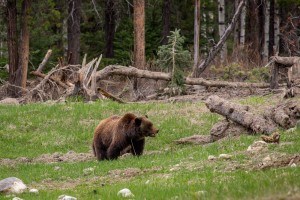
Two types of bears inhabit Jasper National Park: the black bear and the grizzly bear.
JNP is fortunate to be home to these unique animals that share our landscape and give us a glimpse into their existence. They’ve been spotted in many locations around the park including the ski slopes at Marmot Basin.
At this time of year, the valley bottoms are especially attractive to bears who are in search of new vegetation and any animals that are weak or died over the winter.
Both black and grizzly bears are scavengers and omnivores, eating both vegetation and meat. However, plants–especially berries and roots–form the mainstay of their diet. This is supplemented by carrion (meat killed by other animals or animals that died naturally) and whatever animals they managed to kill themselves.
The grizzly bear, Jasper's monarch, has a large muscular hump on its shoulders. The grizzly's face is concave in profile, its fur is long and thick and it can weigh up to 250 kg. The grizzly's colour varies, but is usually light brown with some blond or white hairs giving it a grizzled or silver-tip effect. The claws are long and yellow or brown in colour. Averaging 15 cm in length, these claws are used for digging small mammals out of their dens or extracting roots. Generally an adult grizzly bear cannot climb trees, although a bear can use its massive strength to pull itself up using branches.
The black bear is commonly seen in forested areas, along roadsides and in campgrounds. It is smaller than the grizzly (weighing about 170 kg), lacks a hump on its shoulders, and has a straight, tan muzzle. Their colour varies from black to cinnamon while white patches on their chests are common. Short curved claws make them agile tree climbers.
Bears are extremely sensitive to the stress of human activity. You can help protect these animals by avoiding encounters with them.
Make noise! Let bears know you are there. Call out, clap hands, sing or talk loudly – especially near streams, dense vegetation and berry patches, on windy days, and in areas of low visibility. Bear bells alone are not enough. Watch for fresh bear signs. Tracks, droppings, diggings, torn-up logs and turned-over rocks are all signs that a bear has been in the area. Leave the area if the signs are fresh. Keep your dog on a leash at all times or leave it at home. Dogs can provoke defensive behaviour in bears and can lead the bear back to you if the dog is off leash.
Larger groups of people are less likely to have a serious bear encounter. Hiking in a tight group of four or more is recommended. Never let children wander. Use officially marked paths and trails and travel during daylight hours. If you come across a large dead animal, leave the area immediately and report it to park staff. Carry bear spray and know how to use it.
Knowing how to avoid an encounter is the best way to safely enjoy the park as bears generally prefer to avoid people. However, encounters between bears and people do occur. These encounters generally end without injury and very rarely result in attacks. In the unlikely event you do come across a bear, it is important to know a bit about bear behaviour. How we should respond in an encounter with a bear depends on the type of interaction that is taking place. In general, there are two kinds of interactions: defensive and predatory.
A defensive encounter occurs when a bear is feeding, protecting its young and/or is surprised by your presence, and sees you as a threat. In the event of a defensive attack, you should use your bear spray. If the bear makes contact play dead. Lie on your stomach with legs apart and position your arms so that your hands are crossed behind your neck. This position makes you less vulnerable to being flipped over and protects your face, the back of your head and neck. Remain still until you are sure the bear has left the area.
A predatory encounter is extremely rare and occurs when the bear is following you along a trail or surprises you at night. It may be curious, after your food, testing its dominance or in the rarest case, it might be seeing you as potential prey. In the event of a predatory attack, try to escape into a building, car or up a tree. If you cannot escape, do not play dead. Use your bear spray and fight back! Intimidate the bear: shout, hit it with a branch or rock, do whatever it takes to let the bear know you are not easy prey.
If you are in a vehicle and come upon a bear, drive with care and reduce your speed. Please stay in your vehicle when watching roadside bears and do not feed a bear or follow them into the forest.
If you must stop it is important to be aware of the traffic around you. Pull over where it is safe to do so and use your hazard lights to alert other drivers and if a traffic jam develops, move on. It is unsafe for people and bears. Please drive on and give bears the space they need to remain safe and wild in Jasper National Park. By following these tips you can ensure that visitors and bears can continue to safely cohabitate in Jasper National Park. For further information about bear safety in Jasper National Park, please visit the Parks Canada website at www.pc.gc.ca/Jasper.
Parks Canada
Special to the 51����
